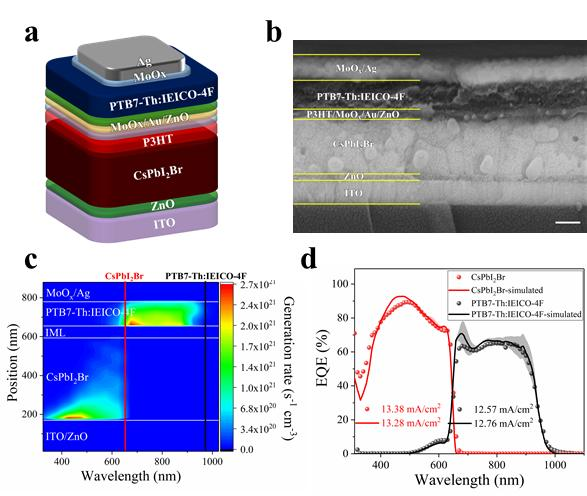Inorganic perovskite‐based solar cells (PSCs) are making steady progress toward commercialization, thanks to the recent development of inorganic PSCs that exhibit remarkably improved power conversion efficiency (PCE) of 18.04%, close to 20%. This confirms the viability of PSC technology for transition to commercial-scale manufacture.
Professor Sung-Yeon Jang and his research team in the School of Energy and Chemical Engineering at UNIST demonstrated the low‐temperature solution‐processed two‐terminal hybrid tandem solar cell devices based on spectrally matched inorganic perovskite and organic bulk heterojunction (BHJ). By matching optical properties of front and back cells using CsPbI2Br and PTB7‐Th:IEICO‐4F BHJ as the active materials, the research team achieved a remarkably higher PCE (18.04%) in the hybrid tandem device as compared to that of single‐junction devices (9.21% for the CsPbI2Br and 10.45% for the organic BHJ devices).
 Figure 1. (a) Structure of the hybrid tandem solar cell device. (b) Cross‐sectional SEM image and (c) energy level diagram of a hybrid tandem device. The scale bar represents 150 nm. (d) J-V characteristic of the hybrid tandem device under AM 1.5G one‐sun illumination. e) Stabilized current output of the hybrid tandem device at the VMPP (1.42 V). f) Experimental and simulated EQE of the front and back cells in the hybrid tandem device.
Figure 1. (a) Structure of the hybrid tandem solar cell device. (b) Cross‐sectional SEM image and (c) energy level diagram of a hybrid tandem device. The scale bar represents 150 nm. (d) J-V characteristic of the hybrid tandem device under AM 1.5G one‐sun illumination. e) Stabilized current output of the hybrid tandem device at the VMPP (1.42 V). f) Experimental and simulated EQE of the front and back cells in the hybrid tandem device.
In the study, the research team successfully demonstrated the great potential of monolithic hybrid tandem solar cells based on inorganic perovskite and organic BHJ photoactive materials. The remarkable improvement in stabilized PCE from the single‐junction device (9.21 and 10.45%) to the hybrid tandem device (18.04%) was achieved because of near‐optimal absorption spectral match between the two sub‐cells.
According to the research team, the PCE of 18.04% in the hybrid tandem is thus far the highest performance among the reported tandem devices based on perovskite and organic materials. Moreover, the hybrid tandem device designed in this study demonstrated improvement in long‐term stability under humidity stress, which is due to the hydrophobicity of the organic BHJ back‐cell layer. In addition, this study rationally suggested the possibility of achieving a PCE of as much as ≈28% in the inorganic perovskite/organic hybrid tandem devices by improving EQE and reducing energy loss in the sub‐cells.
The findings of this research have been published in the October 2020 issue of the Advanced Energy Materials. This work has been supported by the Mid-career Researcher Program and the Technology Development Program to Solve Climate Changes through the National Research Foundation (NRF).
Journal Reference
Havid Aqoma, Imil Fadli Imran, Febrian Tri Adhi Wibowo, et al., "High‐Efficiency Solution‐Processed Two‐Terminal Hybrid Tandem Solar Cells Using Spectrally Matched Inorganic and Organic Photoactive Materials," Advanced Energy Materials, (2020).






